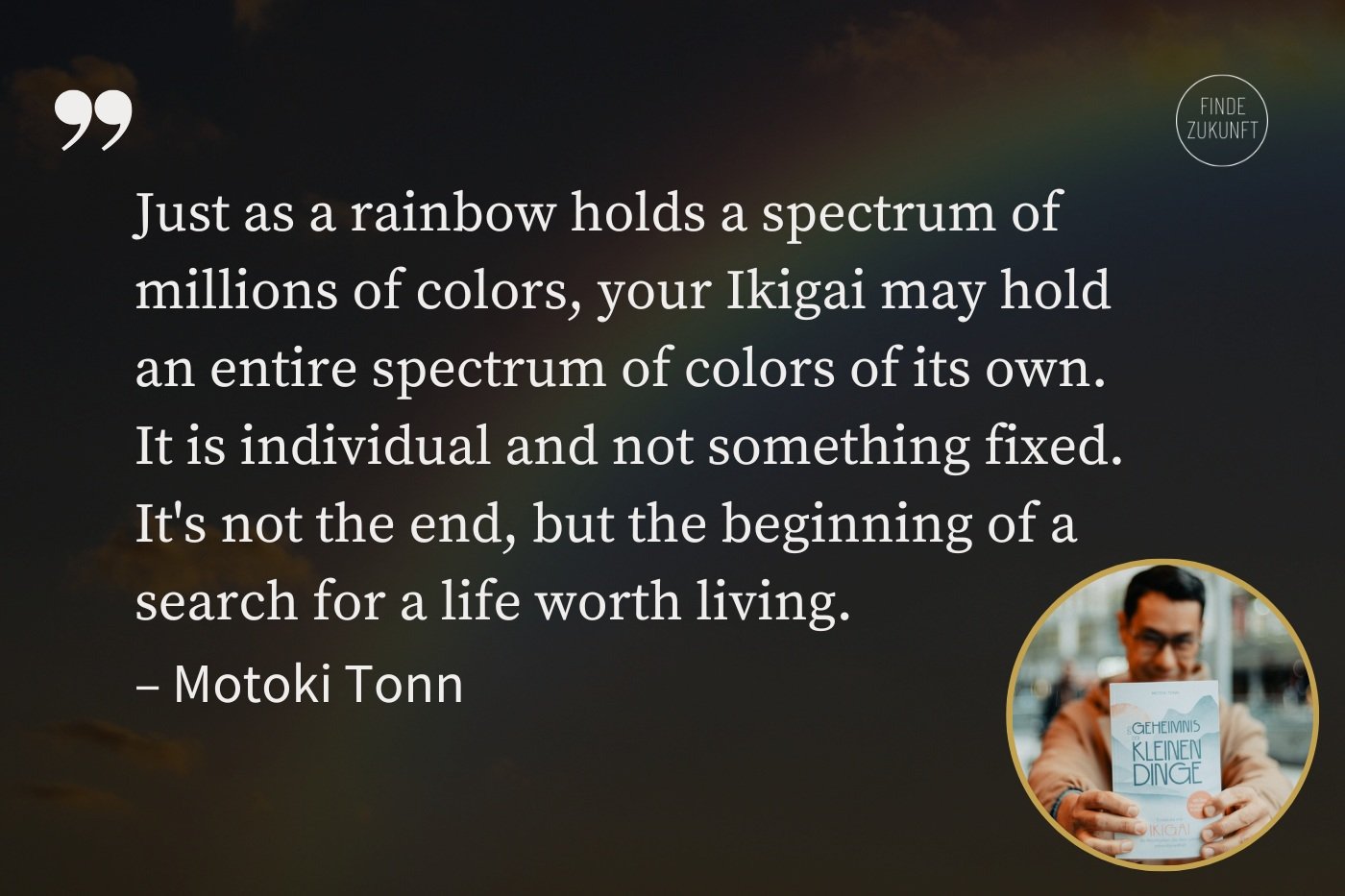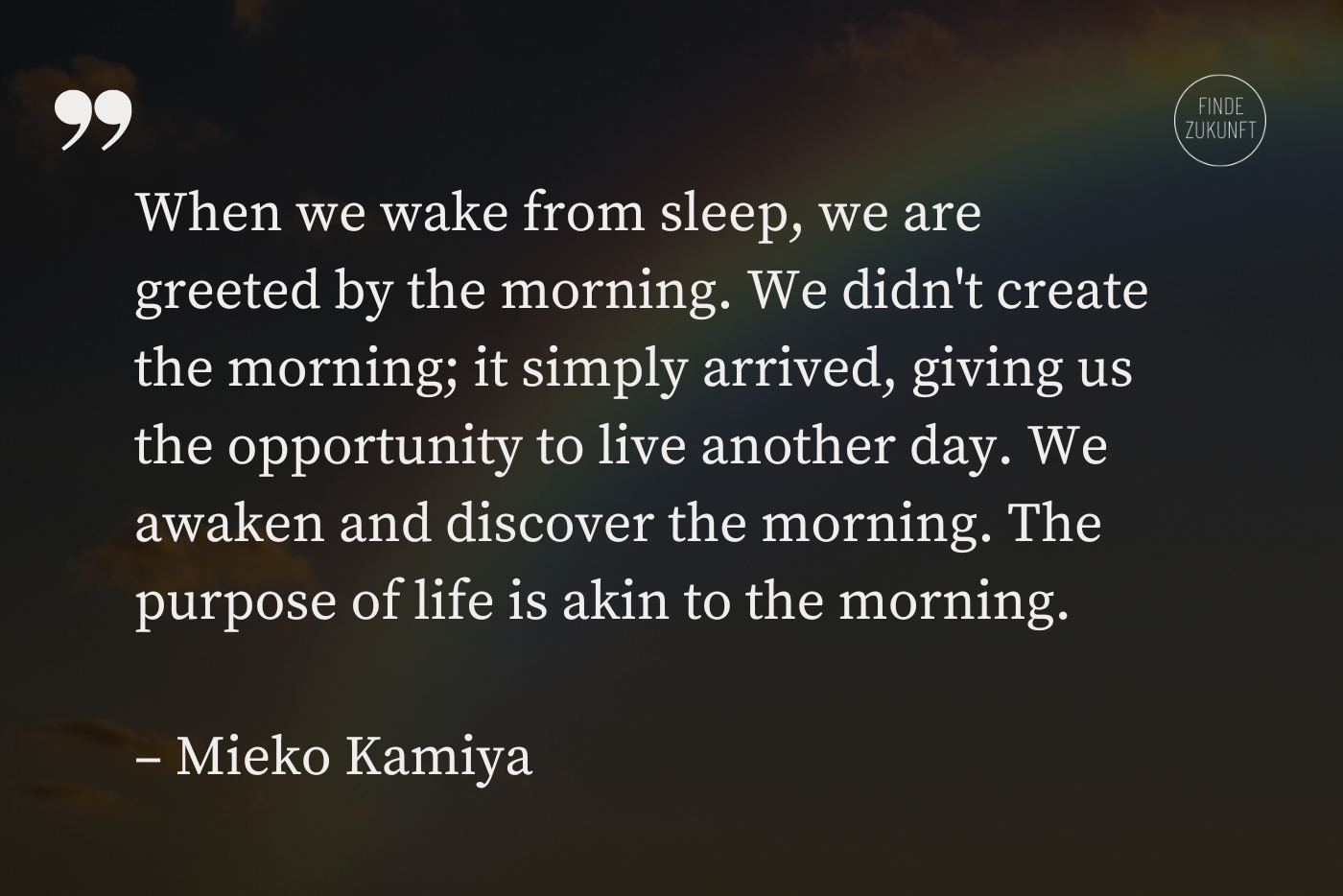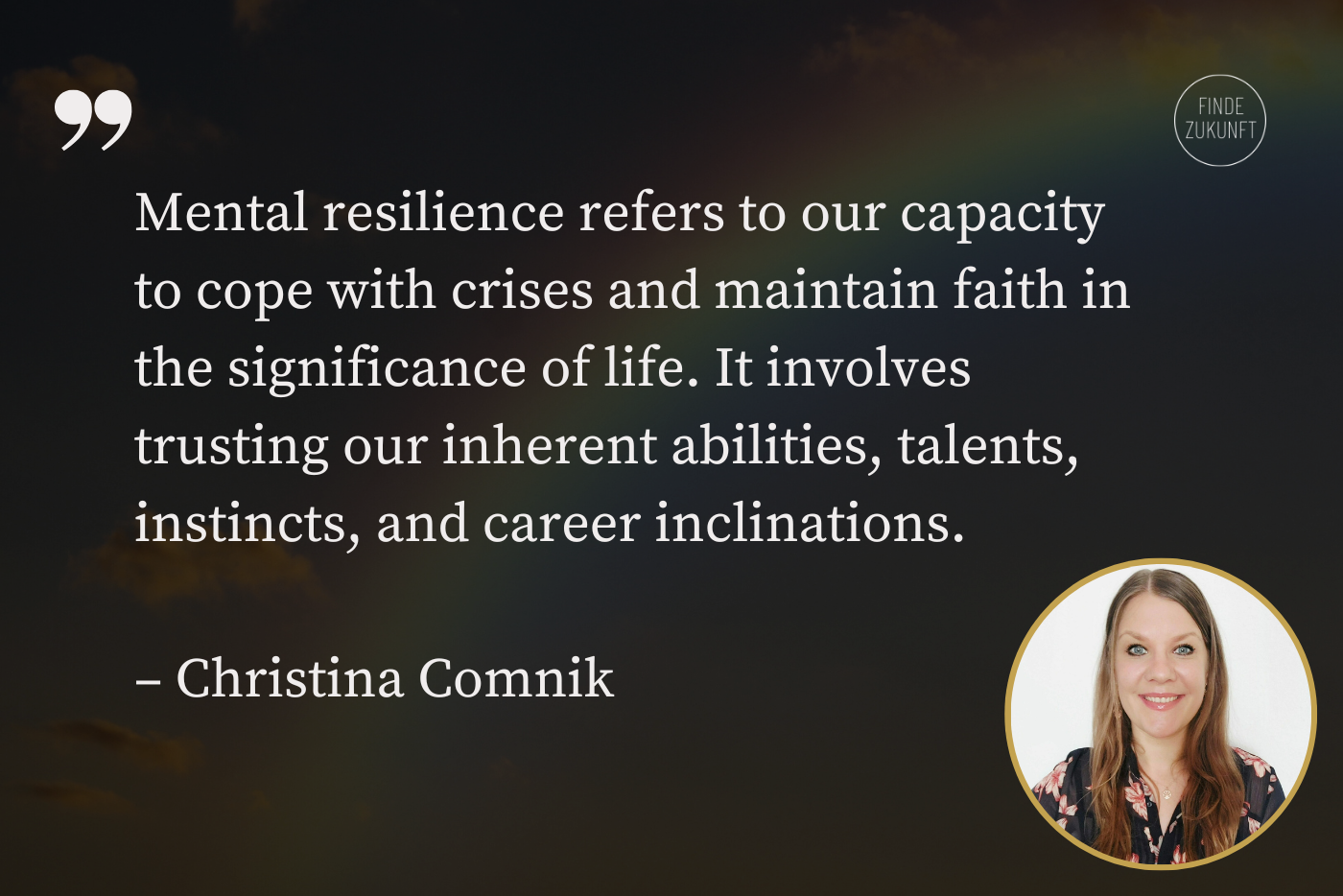Ikigai: The Japanese Art of Fostering Mental Resilience and Pursuing Meaning in Life
This is a translation of the article by Christina Comnik and Sebastian Mauritz, founder of the Resilienz Akademie. You find the original article and many more articles about resilience here.
Have you ever heard of "Ikigai"? If not - this may now change quickly!
If yes: Then the question is: How and what exactly have you seen?
There seems to be a considerable misunderstanding, or should we say, a scandal.
This pertains to the concept of 'Ikigai', as outlined by Klaus Motoki Tonn, an Ikigai Coach and the author of "Ikigai: The Secret of Small Things" (2023). He refers to this misinterpretation as the "IKIGAI SCANDAL", illustrating it as being akin to the widespread misconceptions about stress.
Keen to illuminate this subject, Motoki Tonn, with his team at "Finde Zukunft", embarks on elucidating the real meaning of 'Ikigai'.
To break it down, 'Ikigai' combines 'Iki', which denotes 'life', with 'Kai' or 'Gai', symbolising 'value' or 'valuable'.
As we dive deeper into this exploration, we uncover fascinating facets of Japanese culture. Moreover, we stumble upon intriguing parallels to the notion of resilience. Tonn's ambition, detailed in the book released by Resilienz Akademie in 2023, is to unravel these complexities, thereby exposing the elegant simplicity and profound influence of the Ikigai doctrine.
Why are we dealing with Ikigai?
In our exploration of Mental Resilience, we specifically delve into the protective facet of 'meaning'. This leads us to probe into questions such as: How does the experience of purpose influence our stress management and overall health? What role do our sources of meaning play when we find ourselves amidst grave crises, and how might they bolster our ability to cope?
You can unearth answers to these questions in texts like "Meaning in Crises and Experiencing Suffering", among others.
Naturally, our focus is drawn to the seminal work of Viktor E. Frankl (1905-1997), the founder of logotherapy (from the Latin 'lógos' denoting 'meaning, content'), a form of meaning-centred psychotherapy, and existential analysis. His contributions are invaluable when it comes to engaging with the themes of meaning and resilience, offering some of the most significant resources on these subjects.
Yet, were you aware that during the same era as Viktor E. Frankl, a remarkable woman named Mieko Kamiya (1914-1979) was undertaking her own exploration into the essence of meaning in Japan? She is affectionately hailed as the "Mother of Ikigai Psychology".
It was through the invaluable insights and research efforts of Motoki Tonn and his team that we became cognisant of this extraordinary individual. Kamiya's pivotal work, "Ikigai ni Tsuite" ("On the Meaning of Life" or "What Makes Our Life Worth Living"), penned in 1966, truly stands out. In this work, she even made direct reference to Viktor E. Frankl, demonstrating an interesting confluence of thoughts across different cultures:
„There are two ways of using the word “Ikigai”: It can refer to the source or object of life’s value, as in “This child is my ikigai”, or it can refer to the mental state of feeling ikigai. The latter is what Frankl calls the “sense of meaning”. I will call it “Ikigai-Kan” to distinguish it from the former “Ikigai” itself.“
Mieko Kamiya - A look into the Japanese study of meaning.
Mieko Kamiya was a woman of many talents – a doctor, psychiatrist, author, and translator. Proficient in multiple languages, she taught psychiatry at various universities and was the pioneer researcher on Ikigai. Her chief focus lay with the leprosy patients, an often marginalised and seriously ill population. Her seminal work "Ikigai Ni Tsuite" was largely born out of her experiences and interactions with these individuals.
Kamiya's life, much like Viktor E. Frankl's, was marked by a profound loss in her early years : Having experienced the heart-wrenching loss of her love, her biography reads as a stirring tale that inspires courage. Despite, or perhaps spurred on by her life experiences, she dedicated her life to studying the purpose of existence and the implications of its absence.
Regrettably, since her book never saw translation into other languages, her life's work remains largely unrecognised in the Western world. The team at Finde Zukunft has taken up the noble task of disseminating her groundbreaking thoughts, for which we are truly grateful.
In the context of resilience, Kamiya's biography is of significant interest to us. Her story is a potent blend of crises, pain, and a multitude of challenges, counterbalanced by growth, adaptability, and a dedication to assist others arising from these crises. According to Motoki Tonn, her life narrative also bears evidence of internal self-doubt and struggle. Yet, it was through writing about and researching Ikigai that she seems to have found her true calling.
„Oh god, if this is truly my mission, please give me the will and power to accomplish it. Please keep me alive until I complete this work.“
For us, it's particularly intriguing that Kamiya dissected Ikigai into two distinct facets: "Ikigai sources" and "Ikigai feelings", as indicated in the above quote. The latter reflects the emotions that individuals experience when they uncover meaning in their lives.
In our exploration of resilience, we parallelly focus on these two aspects. On one hand, we examine the sources - our protective factors from which we garner fresh fortitude to navigate stress and crises. On the other, we underscore the vital role of emotions, and how resilience can be deliberately guided and bolstered through emotion regulation.
So what is behind Ikigai?
Tracing back to the term "ikiru-kahi" from the Heian period (747 BC to 1192), the concept of Ikigai has been woven into Japanese literature since 1908 (refer www.Finde-Zukunft.de). The term Ikigai is composed of two Japanese syllables:
生き "Iki" symbolizes "life" (verb: Ikiru) and represents birth or daily life.
甲斐 "Kai" signifies "value" or "worth". The suffix "Gai" is used by the Japanese when they deem something valuable. (Reference: Tonn, 2023)
Hence, Ikigai can be best interpreted as something that imbues life with worth. Fascinatingly, the term not only encapsulates the vastness of Japanese philosophy of life but also embodies a rather commonplace notion for the Japanese. They use Ikigai to define anything that infuses their daily life with meaning, value, and preciousness. This idea is tightly knitted with a profound mindfulness and a sense of gratitude; gratitude for life and for the elements that enhance life's worth.
Ikigai is indeed a highly personal entity that cannot be externally determined. Every individual is free to commence their unique journey to uncover their private Ikigai sources. As per M. Tonn, the compelling question isn't exactly what Ikigai is, but rather why it holds such value to the individual and how they incorporate it into their lives.
„Japanese culture can be quite contrasting to our European culture, and that’s what captivates many, often engulfing them in its mystery. This enigma of Japanese culture is inherently encapsulated in Ikigai. Consequently, any indirect translation fails to capture its authentic essence.“
Ikigai is not just a diagram
As initially indicated, "Ikigai" is commonly associated with a four-circle diagram featuring four central questions. However, Motoki Tonn notes two crucial considerations:
The diagram's creator is the Spanish astrologer Andrés Zuzunaga, whose name is seldom mentioned. He designed his model "Propósito" in 2012, contemplating the question of meaning ("Purpose");
yet he didn't employ the term "Ikigai". His intention was to inspire individuals to recognize meaning in their work, aligning with the questions: What is my passion? What am I good at? What does the world need? What will the world pay me for?
According to M. Tonn, the "strikingly straightforward meaning template" resonated widely because humans crave clear answers, particularly when addressing complex matters such as purpose and vocation. The diagram garnered fame mainly through Marc Winn, a blogger and author who discovered Andrés Zuzunaga's model during his research on Ikigai and the longevity of the Japanese people.
Winn labeled the diagram as "Ikigai", and through blog posts and TED Talks, the diagram became globally synonymous with Ikigai. It's now even included in training programs. Presently, numerous coaches and trainers advocate that by answering the four questions and their corresponding overlaps, one can swiftly discover their life's personal meaning.
„The sum total of my effort was that I changed one word on a diagram and shared a ‘new’ meme with the world.“
Motoki Tonn underlines that the four questions coupled with the Venn diagram might be appealing and situationally relevant when discussing career orientation and financial matters. Nevertheless, it's vital to recognize the confusion as the aspect of money is completely absent in Ikigai's true connotation.
„Japanese people are profoundly surprised by all this because the diagram has nothing to do with the true Japanese meaning of Ikigai.“
What's the real essence?
As Viktor E. Frankl noted, the pursuit of life's purpose is a deeply individualized process that brings us face to face with our existential roots. When we allow the essence of life to hinge upon external variables or the question of monetary reward, we risk missing the true meaning of Ikigai entirely. As Motoki Tonn said in a dialogue with Sebastian Mauritz at the Resilience Congress in 2022:
„Your career will not visit you when you are in hospital.“
From Motoki Tonn's perspective, the Eastern tradition of Ikigai doesn't question how one might maximize earnings, but rather seeks to recognize the existing wealth within one's life. It's about the attitude: "The how and why of your actions bear more weight than what you do." Especially in Western cultures, people are prone to emphasize the "what." However, genuine Ikigai transcends social standing and is devoid of the pressures of career advancement or profit motivation.
How does Ikigai foster resilience?
The connection to Viktor E. Frankl's work is indeed intriguing. Much like logotherapy, the Japanese concept of Ikigai shifts focus from the question of why to the purpose behind our actions and how we might apply and bolster our resources and experiences, particularly those gained from crisis, for the future.
At its core, Ikigai is about recognizing the aspects and moments of life that make life worth living. We can challenge ourselves to consider: Through what lens are we viewing our day? How aware are we of the little treasures in our lives? Ikigai is an attitude, it’s about valuing the seemingly insignificant things that fuel us for the tribulations of tomorrow.
"Ikigai gives life meaning and that gives us the endurance to press on." - Ken Mogi, 2022.
The Five Pathways to Ikigai
In his book "Ikigai. The Japanese Art of Living," Ken (Kenchiro) Mogi lays out five strategies to foster more Ikigai in your life. The team at “Finde Zukunft” offers some insights and also developed it further:
Firstly in the five pillars of Kenchiro Mogi, we can find six elements
The team transformed this six elements into six questions for our daily lives. By this, we can apply ikigai practically and meaningfully
By adding the seven ikigai-needs of Mieko Kamiya, it became a larger framework to foster ikigai holistically and yet practically.
Let’s see how the five pillars of Ken Mogi provide six questions for life:
Starting small: What minor aspects could you pay more attention to?
Releasing yourself: What can you let go of?
Harmony: How can I foster more harmony in my life?
Sustainability: How can I live a life of “less is more” in a metaphorical sense? How can I live and engage in my relationships more sustainable?
Finding joy in the little things: How can we become more aware for the so-called little things?
Living in the present moment: How can I become more present in the here and now?
Ken Mogi gives the example of the "little things" such as the Japanese ritual of having a sweet treat and a traditional green tea in the morning. In Japan—the "Land of the Rising Sun"—it is customary to rise early, in alignment with the sun's ascent.
The sun, being an object of reverence and a symbol of life and vitality, has immense cultural significance in Japan. Science backs this up: morning rituals and natural sunlight have a plethora of positive impacts on the body, mind, and spirit. They activate the brain's reward center, trigger the release of pain-relieving and motivational hormones like serotonin, dopamine, and noradrenaline, and have been shown to bolster the immune system.
Aligning with the day-night rhythm—living in harmony with the sun—holds deep cultural significance for the Japanese. A key element of Japanese culture is harmony, or "Wa" (和), which was named as a crucial principle of the state in Japan's first constitution and is closely tied to Ikigai, as a life philosophy.
„This harmony goes beyond merely the absence of negativity (war, conflict), it signifies the presence of a peaceful quality.“
Impacts on Health
Ikigai manifests in the things that motivate individuals to face another day. Perhaps even in the face of severe adversity and hardship. International research into the concept of purpose explores what factors internally motivate individuals, allow them to find meaning, and how this affects their physical, mental, and spiritual well-being.
IKIGAI HEALTH Research
A Japanese study involving 43,000 participants inquired about their "Ikigai" and found that those who spoke of having discovered their Ikigai reported significantly improved physical health seven years later. They experienced less pain and impairment of physical function. In contrast, individuals without Ikigai were shown to have a 50% higher risk of mortality within the seven years of the study (see Schnell, 2020; reference to Sone et al., 2008 study).
Additionally, sensory research confirms that Ikigai reduces cardiovascular diseases, rheumatism, cancer, and inflammation levels. The island of "Okinawa" in the East China Sea is famous for its residents' high life expectancy, attributed to a strong Ikigai. The island is home to "(...) an unusually high number of active and healthy centenarians who practice their Ikigai every day" (see Find Future). Research supports that psychosocial factors significantly impact life expectancy and that Ikigai, as an attitude, is reflected, for example, by a high level of daily mindfulness and an appreciation of life.
Make Time and Space for What Nourishes You
What are some rituals that are important to you and nourish your soul?
Often it's habits or deeply ingrained rituals that are imbued with meaning and reveal many significant values. For instance, Japanese people often gather for morning exercise in the park or commute to work together daily, making the train ride more enjoyable by engaging in a game or shared activity (Ken Mogi, 2022). This highlights values and protective factors like social support, bonding, community, creativity, etc.
IKIGAI and Flow
A strong indication of personal meaning is when you lose track of time and space—maybe because you're engaging in a passion. Something that stimulates your senses and allows you to simply enjoy the moment. Ikigai can reveal itself in making sushi, in paying attention to details, caring for someone else, being close to nature, gardening, or expressing itself in creative acts and art—dancing, making music, drawing or mastering a craft. When people are entirely in "their element" and concentrate on one thing, we refer to this as a "flow state" (as per Mihály Csíkszentmihályi).
Personal reflecion
Perhaps take a moment in the coming week to notice: Where do you lose track of time and space? What makes you appreciate the little details? What puts you in a productive state and gives you the feeling that maybe you would want to rise again the next day for that alone?
Where Does Ikigai Lead Us?
„When we wake from sleep, we are greeted by the morning. We didn’t create the morning; it simply arrived, giving us the opportunity to live another day. We awaken and discover the morning. The purpose of life is akin to the morning.“
Mieko Kamiya's insights touch us deeply, and her research illustrates how closely Ikigai is related to the protective factors of (mental) resilience. In her pursuit of understanding meaning, she formulated seven dimensions that foster Ikigai:
Life satisfaction
Growth and change
A perspective for a bright future
Resonance
Freedom
Self-actualization
Meaning and Value
„The dimensions demonstrate how comprehensive and existential Ikigai is and the importance of creating meaning in our lives. “
For example, "growth and change" uncovers a resilient mindset—to learn from crisis experiences and to embrace change with an open and curious attitude. Following this, "self-actualization" is also a vital resilience factor—getting involved, being brave, trying new things, and using resources for those things that align with our own values and allow our potential to flourish.
ikigai, Confidence and Mental resilience
„Mental resilience refers to our capacity to cope with crises and maintain faith in the significance of life. It involves trusting our inherent abilities, talents, instincts, and career inclinations.“
To remember again the original resources that life has given us, and which we can rely on—even in the face of extreme hardship. For they are always there—the question is only how aware we are of them and what we actively do to actualize ourselves with them.
Resonance and Mental resilience
The concept of "resonance" is also incredibly interesting and an added value for our mental resilience. How do we resonate with ourselves or our environment? Motoki Tonn, for example, describes his sense of resonance as being "in harmony with the rhythm of nature".
„Ikigai appears in the vibrations (the experience of resonance) we perceive in such moments of harmony.“
Soul (mental) resilience is also about this primal, unique way of perception and resonance. Intuition is a key element of soul resilience, to "(re)establish connection". To connect with other people (and/or a higher reality) and to be able to trust in this aid even in crises. The belief in things that "resonate"—which we cannot describe with our cognitive mind—but which we can feel all the more for it. Prof. Dr. Alfried Längle, one of Viktor E. Frankl's most well-known students, also speaks of "letting oneself be moved" — by the purpose in life.
Touch and Fulfillment
And it is precisely this sense of being moved that we find in the study of Ikigai—this mystery that M. Tonn speaks of. Not to force everything into a mold, but to let oneself in, to discover new things, and be surprised by moments of Ikigai. It is this space that allows for a true, deep connection. Then we are in touch with our soul. Then purpose fortifies our mental health.
Through moments when we can smile sincerely again or when we are brought together with other people. The things that allow us to face tomorrow, no matter how difficult it may be, and perhaps even—like Mieko Kamiya—lead to a form of calling.
„Just as a rainbow holds a spectrum of millions of colors, your Ikigai may hold an entire spectrum of colors of its own. It is individual and not something fixed. It’s not the end, but the beginning of a search for a life worth living.“
Links and Recommendations about the authors
Christina Comnik: https://christinacomnick.de/
Sebastian Mauritz: https://www.sebastianmauritz.de/
Resilienz Akadamie: https://www.resilienz-akademie.com/









